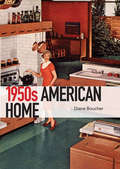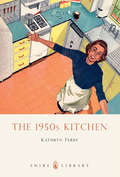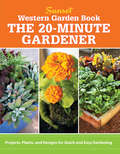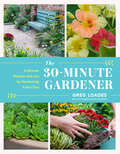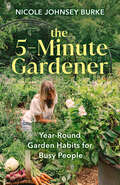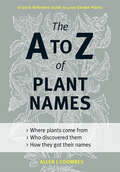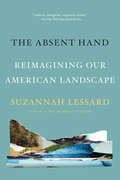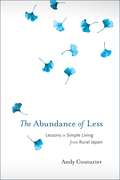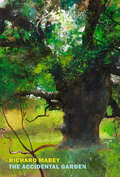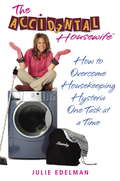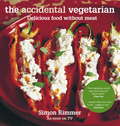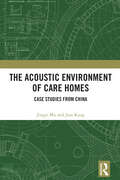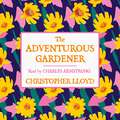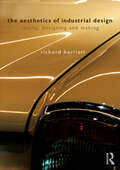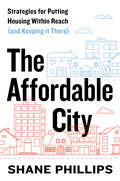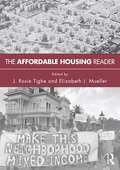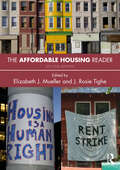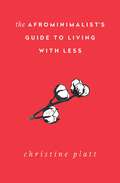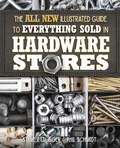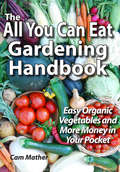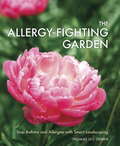- Table View
- List View
The 1950s American Home
by Diane BoucherThis title explores what life was like in the 1950s American home. An age of optimism, it is about living the American Dream and how this was achieved, changes in the home, new convenience technology, new ways of living. From Ranch House to American Modernism to affordable homes in the suburbs, this was how to live the good life in an era of unprecedented prosperity and opportunity.From the Trade Paperback edition.
The 1950s Kitchen
by Kathryn FerryThe 1950s was the first great age of the modern kitchen: labor-saving appliances, bright colors and the novelty of fitted units moved the kitchen from dankness into light, where it became the domain of the happy housewife and the heart of the home. Formica - a new space-age material - decorated with fashionable patterns topped sleek cupboards that contained new classic wares such as Pyrex and 'Homemaker' crockery, and the ingredients for 1950s British staples: semolina, coronation chicken and spotted dick. Electricity entered the kitchens of millions, and nowhere in the home was modern technology and modern design more evident. Bold color, clean lines and stainless steel were keynotes of the decade, and it is no surprise that 1950s kitchen style is now the height of fashion once again, with names like Cath Kidston picking up on the best of '50s kitchen kitsch, and manufacturers like Dualit, Kitchen Aid and Aga doing healthy business with retro appliances. This book - a celebration of cooking, eating and living in the 1950s kitchen - is a feast of nostalgia, and a mine of inspiration for anyone wanting to recreate that '50s look in their own home.From the Trade Paperback edition.
The 20 Minute Gardener: Projects, Plants and Designs for Quick & Easy Gardening
by Editors of SunsetIn the Western Garden Book: The 20-Minute Gardener learn the secret to achieving a beautiful garden with minimum effort, paying attention to it in brief time increments all week and season long rather than devoting long days on weekends. Make the process fun. Take an early-morning stroll through your garden, picking off spent blooms as you go, or in the evening after work; pull stray weeds or harvest tomatoes for dinner. This informative guide helps seasoned and new gardeners alike plan easy-to-tend garden spaces, choose low-maintenance plants, grow edibles that keep on giving (artichokes, asparagus, blueberries, citrus) and monitor your plants daily rather than weekly. With garden techniques and projects you will find all the tips and step-by-step instruction needed to create a stylish yet easy-to-maintain outdoor space.
The 30-Minute Gardener: Cultivate Beauty and Joy by Gardening Every Day
by Greg LoadesFind happiness, connection, and accomplishment by cultivating your garden life every day of the week using this inspiration-packed guide that shows aspiring gardeners exactly what they need to know. Are you ready to discover your garden&’s unexpected gifts? All it takes is a daily practice. In The 30-Minute Gardener, Greg Loadesreveals what dedicated time spent in the garden every day can create: a moment of solitude in a busy world, a welcoming space to enjoy with family and friends, and an increased connection to nature. In this practical and inspiring guide you&’ll find advice on tasks such as pruning a rose bush and planting bulbs, inspired ideas for transforming an overgrown garden into a beautiful flower-filled haven, and hints on how best to savor your garden and enjoy your accomplishments.
The 5 Minute Clean Routine: Tips and Tricks for a Happy Home
by Anna Louisa'A cleaning guru' - Daily Mail'A cleaning bible of ingenious advice and practical guidance' - MirrorTake the stress out of your home cleaning routine with the easy-to-use guide and planner, featuring over 100 cleaning techniques, plus tried and tested hacks and list pages to tick off as you go! In The Five Minute Clean Routine, Anna Louisa (also known as @anna_louisa_at_home) shares her secrets to a fresh, shining home. Breaking down household cleaning tasks into 5-minute chunks, Anna Louisa shows how you can create a satisfying routine that works for you for every room - from kitchen to bathroom and everywhere in between. Written in Anna’s trademark warm style, this book is bursting with ideas to make both everyday and deep clean tasks totally hassle free, whether it's getting rid of grease from your air fryer, vanishing limescale in an instant or using store cupboard ingredients to keep your home smelling fresh. Including: Over 100 cleaning techniques for the homeTried and tested cleaning product combinationsPlanner pages and lists to tick off as you goThe Five Minute Clean Routine promises to show how your household and cleaning routines can become easy and efficient. __________________________________________________________________________Reader reviews'Highly recommend for anyone looking for quick and effective cleaning tips!''Lots of practical tips to keep on top of the housework and make it more manageable. It also looks beautiful on my coffee table!''Perfect to help with organizing your own cleaning routine''Makes cleaning a lot more enjoyable'
The 5-Minute Gardener: Year-Round Garden Habits for Busy People
by Nicole Johnsey BurkeNurture a year-round gardening habit with just 5 minutes a day, from the author of Kitchen Garden Revival and Leaves, Roots & Fruit.Do you find joy in seeing a plant grow from seed to flower? Has your main setback for maintaining a successful garden been finding enough time to tend it?Whether you have a windowsill garden or a backyard full of flora, finding time to garden can seem impossible. But with just 5 minutes a day, you can be sure your plants have all they need to go from seed to delicious harvest. Nicole Johnsey Burke, author of Kitchen Garden Revival and Leaves, Roots & Fruit and founder of Gardenary, Inc., guides you through the different planting seasons and shares:Quick, actionable tasks: minimal methods to keep your garden thriving Seasonal gardening plans: detailed schedules broken down into days, weeks, and monthsHabit-building techniques: proven ways to integrate gardening into your daily routineGarden-to-table benefits: easy, delicious dishes you can quickly pull together with your fresh-picked produceNicole equips you with the knowledge you need to transform 5 minutes a day into a year-round gardening habit. Experience the joy and mindfulness that comes from being more connected to nature and the food you eat.
The A to Z of Plant Names: A Quick Reference Guide to 4000 Garden Plants
by Allen J. CoombesBotanical names can be baffling to even the most experienced gardener. But a plant's botanical name is more than just a handy label—it can tell a plant's country of origin, the shape of its leaves, the color of its petals, and much more. The A to Z of Plant Names clears the confusion and allows every gardener to name plants with confidence. This comprehensive yet handy guide features the botanic names of the plants that gardeners really grow. Additional information includes suggested pronunciation, the common name, the derivation of the scientific name, the number of species currently accepted, the type of plant and the distribution. The A to Z of Plant Names helps demystify names, provides readers with the intriguing background information to naming conventions, and empowers gardeners everywhere to feel confident about naming plants.
The Absent Hand: Reimagining Our American Landscape
by Suzannah Lessard"Of beach plums, ramps, and Ramada Inns: a quietly sensitive eminently sensible consideration of the landscapes of our lives . . . A gift." —Kirkus ReviewsFollowing her bestselling The Architect of Desire, Suzannah Lessard returns with a remarkable book, a work of relentless curiosity and a graceful mixture of observation and philosophy. This intriguing hybrid will remind some of W. G. Sebald’s work and others of Rebecca Solnit’s, but it is Lessard’s singular talent to combine this profound book–length mosaic— a blend of historical travelogue, reportorial probing, philosophical meditation, and prose poem—into a work of unique genius, as she describes and reimagines our landscapes. In this exploration of our surroundings, The Absent Hand contends that to reimagine landscape is a form of cultural reinvention. This engrossing work of literary nonfiction is a deep dive into our surroundings—cities, countryside, and sprawl—exploring change in the meaning of place and reimagining the world in a time of transition. Whether it be climate change altering the meaning of nature, or digital communications altering the nature of work, the effects of global enclosure on the meaning of place are panoramic, infiltrative, inescapable. No one will finish this book, this journey, without having their ideas of living and settling in their surroundings profoundly enriched.
The Abundance of Less: Lessons in Simple Living from Rural Japan
by Andy CouturierAndy Couturier captures the texture of sustainable lives well lived in these ten profiles of ordinary—yet exceptional—men and women who left behind mainstream existences in urban Japan to live surrounded by the luxuries of nature, art, friends, delicious food, and an abundance of time. Drawing on traditional Eastern spiritual wisdom and culture, these pioneers describe the profound personal transformations they underwent as they escaped the stress, consumerism, busyness, and dependence on technology of modern life. This intimate and evocative book tells of their fulfilling lives as artists, philosophers, and farmers who rely on themselves for happiness and sustenance. By inviting readers to enter into the essence of these individuals’ days, Couturier shows us how we too can bring more meaning and richness to our own lives.
The Accidental Garden: Gardens, Wilderness, and the Space In Between
by Richard MabeyOne of Britain&’s greatest nature writers blends horticulture with philosophy in this intimate memoir about gardening, rewilding, and a path forward amid climate change.What is a garden? Is it an arena for the display of human mastery or might it be something less determined, more generous? These are questions that Richard Mabey, arguably England's greatest nature writer, considers in his new book, The Accidental Garden. From the pressing surrounds of the inventive, half-wild garden that Mabey, an instinctive rewilder, and his partner Polly, a determined grower, have shared for two decades, Mabey weighs past hopes and visions against the environmental emergency of the present. In beeches and bush crickets he sees proof of adaptation and survival; in commons and meadows he finds natural processes still at work. A wise and witty stylist, Mabey locates in his small patch of the planet a place to test assumptions and to observe how myriad species establish common ground.
The Accidental Housewife
by Julie EdelmanHOUSEKEEPING 101 Accidental Housewife (n): an individual who manages the household unexpectedly, unintentionally, by default, or by chance, with minimal skills, a glass of wine, and little interest in mastering her/his domain. Once upon a time lived the 1950s housewife who joyfully followed her domestic duties. Today’s housewife is anything but traditional, yet some things never change: mounting laundry, accumulating dust, looming clutter, and the refrain, “What’s for dinner?” Now Julie Edelman, the go-to gal for entertaining and practical household tips and trends, turns these mundane chores into fun and easy tasks. Offering real life advice and simple solutions, Julie helps you • tidy up with the faucet to floor facelift: a stress-free way to clean with minimum effort to achieve maximum effect, as you dance with dust bunnies and indulge in a bit of pampering along the way • conquer PMS (Pretty Manageable Stains): learn how to painlessly deal with the most common stains using everything from industrial products to everyday items such as hairspray, shaving cream, and ice cubes • practice feng shui my way: harmonize chaos and clutter and get chi (energized) in the process, courtesy of coffee • follow a food and mood planner: uncover innovative ways to balance your family’s nutritional needs with your desire to let them eat cake Inside, you’ll also find Burn This: Housewifely Calorie Counter (you can lose weight vacuuming and lifting loads of laundry) and HI Q (Housewife Intelligence Quotient) tests to measure your housewifely expertise. So drop that mop and grab a latte . . . hassle-free help is at your fingertips! Visit the author's website at www. theaccidentalhousewife. com From the Trade Paperback edition.
The Accidental Vegetarian: Delicious And Eclectic Food Without Meat
by Simon RimmerWhen Simon Rimmer bought a small vegetarian restaurant, he had no idea how to cook. Armed with two cookbooks and heaps of enthusiasm, he and a friend created the best vegetarian restaurant in Manchester, famous for its unusual food and lovely atmosphere. A confirmed meat eater, Simon had to rethink his cooking and has created vegetarian recipes to please even the most dedicated carnivore. This book is a collection of some of his recipes that are quick to prepare but totally delicious. From good old favourites like macaroni cheese to Simon's more exotic fusion creations such as spicy beetroot and coconut soup, The Accidental Vegetarian will kill the lentil and sandal image of vegetarianism forever!
The Accidental Vegetarian: Delicious food without meat
by Simon RimmerDeliciously simple, meat-free recipes from 'Something For The Weekend' presenter and Strictly Come Dancing contestant Simon Rimmer.
The Acoustic Environment of Care Homes: Case Studies from China
by Jian Kang Jingyi MuThis book examines the indoor acoustic environment of China's care homes. Chapter 1 provides a brief introduction to the current situation in China's care homes. This includes the distribution, size, demand, and future development direction of these facilities. The chapter then presents an in-depth introduction and analysis of the indoor environment of these facilities, especially the acoustic environment. In Chapter 2, a case study and site investigation are described, and these are used to analyse the current state of the acoustic environment in these facilities, including the sound pressure level (SPL) and reverberation time (RT). Chapter 3 details the perceptions of the elderly regarding the acoustic environment of care homes and the correlation between the sound environment and other physical environments at the facilities. Chapter 4 presents the impact of the acoustic environment on the well-being of elderly residents and an analysis of the effects of different sound sources on the activities of the elderly. The effects of the acoustic environment on physiological indices of the elderly under different sound sources in care homes are analysed in Chapter 5. Finally, in Chapter 6, certain improvement strategies for the indoor acoustic environment of care homes are proposed based on the analysis. This book is a comprehensive exposition of research on the acoustic environment of care homes in China, and is useful reading for researchers in acoustics, architecture, design, engineering, and healthcare facilities. It could also be used as a scientific introduction for readers interested in this field.
The Adventurous Gardener
by Christopher Lloyd'The best informed, liveliest and most innovative gardening writer of our times' GUARDIAN'Christopher Lloyd ranks with Gertrude Jekyll and Vita Sackville-West as one of the major figures in twentieth-century British gardening' THE TIMESIn this gardening classic the forever adventurous Christopher Lloyd takes us on a tour through the garden, to encourage, to reveal and to overturn the old and accepted when experience prompts him. He advises on cuttings, pruning, the art of compromise and takes another look at Miss Jekyll. Gardening was a passion, and throughout his life he developed Great Dixter to be one of Britain's greatest gardens. For Christo gardening is nothing if not fun and - pointing out that 'to be roused into an argumentative frame of mind is in itself no bad thing' - he makes it equally stimulating and enjoyable for his readers.
The Adventurous Gardener
by Christopher Lloyd'The best informed, liveliest and most innovative gardening writer of our times' GUARDIAN'Christopher Lloyd ranks with Gertrude Jekyll and Vita Sackville-West as one of the major figures in twentieth-century British gardening' THE TIMESIn this gardening classic the forever adventurous Christopher Lloyd takes us on a tour through the garden, to encourage, to reveal and to overturn the old and accepted when experience prompts him. He advises on cuttings, pruning, the art of compromise and takes another look at Miss Jekyll. Gardening was a passion, and throughout his life he developed Great Dixter to be one of Britain's greatest gardens. For Christo gardening is nothing if not fun and - pointing out that 'to be roused into an argumentative frame of mind is in itself no bad thing' - he makes it equally stimulating and enjoyable for his readers.
The Adventurous Gardener (Horticulture Garden Classics Ser.)
by Christopher Lloyd'The best informed, liveliest and most innovative gardening writer of our times' GUARDIAN'Christopher Lloyd ranks with Gertrude Jekyll and Vita Sackville-West as one of the major figures in twentieth-century British gardening' THE TIMESIn this gardening classic the forever adventurous Christopher Lloyd takes us on a tour through the garden, to encourage, to reveal and to overturn the old and accepted when experience prompts him. He advises on cuttings, pruning, the art of compromise and takes another look at Miss Jekyll. Gardening was a passion, and throughout his life he developed Great Dixter to be one of Britain's greatest gardens. For Christo gardening is nothing if not fun and - pointing out that 'to be roused into an argumentative frame of mind is in itself no bad thing' - he makes it equally stimulating and enjoyable for his readers.
The Aesthetics of Industrial Design: Seeing, Designing and Making
by Richard HerriottThis textbook introduces design students to key principles of three-dimensional form, bridging aesthetics and practical design objectives. It explores how we see and what it is that characterises visually appealing and satisfactory design. Written by an experienced designer, educator and researcher, The Aesthetics of Industrial Design equips students with the knowledge and understanding of how aesthetically superior design is distinct from lesser work. It explains the key principles and concepts they can incorporate into their own designs, encourages readers to investigate and experiment with real design problems and enables them to verbally communicate their design intentions. The book prompts readers to critically reflect on their work and surroundings. Through numerous clear examples and illustrated case studies, which are guided by cognitive science and the application of aesthetic theory, the book brings together the basic aspects of design as form-giving. It explores the balance of function, material and appearance in detail and explains the reasons for common aesthetic faults and how to avoid them. Aimed at undergraduate- and postgraduate-level students within the design fields, this book reveals the secrets to aesthetically successful products that readers can take from education into future practice.
The Affordable City: Strategies for Putting Housing Within Reach (and Keeping it There)
by Shane PhillipsFrom Los Angeles to Boston and Chicago to Miami, US cities are struggling to address the twin crises of high housing costs and household instability. Debates over the appropriate course of action have been defined by two poles: building more housing or enacting stronger tenant protections. These options are often treated as mutually exclusive, with support for one implying opposition to the other.Shane Phillips believes that effectively tackling the housing crisis requires that cities support both tenant protections and housing abundance. He offers readers more than 50 policy recommendations, beginning with a set of principles and general recommendations that should apply to all housing policy. The remaining recommendations are organized by what he calls the Three S's of Supply, Stability, and Subsidy. Phillips makes a moral and economic case for why each is essential and recommendations for making them work together.There is no single solution to the housing crisis—it will require a comprehensive approach backed by strong, diverse coalitions. The Affordable City is an essential tool for professionals and advocates working to improve affordability and increase community resilience through local action.
The Affordable Housing Reader
by J. Rosie Tighe Elizabeth J. MuellerThe Affordable Housing Reader brings together classic works and contemporary writing on the themes and debates that have animated the field of affordable housing policy as well as the challenges in achieving the goals of policy on the ground. The Reader – aimed at professors, students, and researchers – provides an overview of the literature on housing policy and planning that is both comprehensive and interdisciplinary. It is particularly suited for graduate and undergraduate courses on housing policy offered to students of public policy and city planning. The Reader is structured around the key debates in affordable housing, ranging from the conflicting motivations for housing policy, through analysis of the causes of and solutions to housing problems, to concerns about gentrification and housing and race. Each debate is contextualized in an introductory essay by the editors, and illustrated with a range of texts and articles. Elizabeth Mueller and Rosie Tighe have brought together for the first time into a single volume the best and most influential writings on housing and its importance for planners and policy-makers.
The Affordable Housing Reader
by J. Rosie Tighe Elizabeth J. MuellerThis second edition of The Affordable Housing Reader provides context for current discussions surrounding housing policy, emphasizing the values and assumptions underlying debates over strategies for ameliorating housing problems experienced by low-income residents and communities of color. The authors highlighted in this updated volume address themes central to housing as an area of social policy and to understanding its particular meaning in the United States. These include the long history of racial exclusion and the role that public policy has played in racializing access to decent housing and well-serviced neighborhoods; the tension between the economic and social goals of housing policy; and the role that housing plays in various aspects of the lives of low- and moderate-income residents. Scholarship and the COVID-19 pandemic are raising awareness of the link between access to adequate housing and other rights and opportunities. This timely reader focuses attention on the results of past efforts and on the urgency of reframing the conversation. It is both an exciting time to teach students about the evolution of United States’ housing policy and a challenging time to discuss what policymakers or practitioners can do to effect positive change. This reader is aimed at students, professors, researchers, and professionals of housing policy, public policy, and city planning.
The Afrominimalist's Guide to Living with Less
by Christine PlattForget the aesthetics of mainstream minimalism and discover a life of authenticity and intention with this &“warm, engaging guide&” (Laura Fenton, author of The Little Book of Small Living) to living with less…your way.When Christine Platt set out on her journey to live with less, she never intended to become The Afrominimalist. She just wanted to tame the chaos in her closet! But after struggling with the austerity and whiteness of mainstream minimalism, Christine realized why minimalism often seems unattainable for so many: the emphasis on all-white, barren aesthetics distracts from the practice of living with intention. And so, she decided to do things her way by curating a life of less influenced by the African diaspora. In The Afrominimalist&’s Guide to Living With Less, Christine gets right to the heart of how childhood experiences and expectations manifest in adulthood, the delicate dance between needs and wants, and the complicated weight of familial and societal pressures. A far cry from Konmaried closets, capsule wardrobes, and conspicuous consumption, Christine&’s brand of &“living with less&” is more than a decluttering regimen. &“By detailing her own maximalist-to-minimalist transformation, Platt puts readers at ease&” (The Washington Post) and presents a radical revisioning of minimalism, one that celebrates the importance of history and heritage, and gives you permission to make space for what really matters…your way. Beautifully illustrated with original black-and-white prints and line drawings, The Afrominimalist&’s Guide to Living With Less is a testament to the idea that anyone can be a minimalist and a warm invitation to a life curated with intention, perfect for readers of Joshua Fields Millburn and Ryan Nicodemus (The Minimalists), Marie Kondo, Joshua Becker, and Courtney Carver.
The All New Illustrated Guide to Everything Sold in Hardware Stores
by Steve Ettlinger Phil SchmidtAn updated edition of the ultimate hardware shopping guide and reference book: “Organized, accessible and cheerfully reassuring.” —Publishers WeeklyTired of making multiple trips to the hardware store because you purchased the wrong item? Or wandering the aisles feeling overwhelmed and bewildered? This is the illustrated reference that helps you learn the difference between drywall screws and deck screws; between faucet washers and neoprene O-rings; and between red wire nuts and blue wire nuts. And that’s before we even get to understanding nail gauges and drill bit sizes. The next time you talk to a hardware store clerk, rather than asking for “screws about two inches long,” you’ll be able to ask for #3 gauge 2-1/4-inch-long panhead screws with SAE 5/16’ flat washers!The All New Illustrated Guide to Everything Sold in Hardware Stores is filled with color photos that let you see in life-size scale what different screws and nails and washers and bolts are called, accompanied by brief descriptions of their recommended uses—so you’ll be able to ask for them with accuracy and use them with precision.“Recommended for beginners: new homeowners and handypersons just getting started.” —Library Journal
The All You Can Eat Gardening Handbook
by Cam MatherThere's never been a better time to grow your own food as we face the converging challenges of the financial crisis, climate change, water shortages, peak oil, and 6.5 billion people worldwide competing for a limited amount of food.Many gardening books are so technical that they are intimidating to the beginning gardener. This book shows how easy gardening can be while providing tips and techniques to ensure success. Whether you live in the country, the city, or the suburbs, you'll learn:How to create lots of rich compost as the basis for vigorous growth Simple techniques to safely deal with pests The most effective techniques for irrigation, including harvesting your rainwater How to store your harvest using canning, freezing, and drying techniques How to build and stock a root cellar How to choose which vegetables to grow based on their nutritional valueThis book is a step-by-step guide to turning your lawn into a great source of personal satisfaction and economic independence. Having an organic produce department in your backyard creates your own "one hundred-foot diet" to reduce your carbon footprint and keep more money in your pocket.Cam Mather has been gardening organically and market gardening for thirty-five years. His entertaining and informative workshops and DVD have inspired thousands of people to get out and get their hands dirty. He publishes books about renewable energy and sustainability from his off-grid solar and wind-powered home office.
The Allergy-Fighting Garden
by Thomas Leo OgrenThe Groundbreaking Guide to Health-Conscious Gardening If you are one of the millions of people with allergies or asthma, this totally unique book shows you how to avoid plants that trigger allergies and to create a garden that will actually protect you by trapping pollen and cleaning the air around you. This revolutionary approach combines the best of horticulturist Thomas Ogren's previous books--Allergy-Free Gardening and Safe Sex in the Garden--into a full-color guide, including hundreds of new and updated plant listings and photographs. Ogren's innovative system for combating allergens is based on the crucial matter of plant sex. By replacing troublesome male plants in your yard with pollen-blocking female "pollen screens," allergy sufferers can reduce or eliminate their symptoms. More than 3,000 plant listings are included, accompanied by an easy-to-use allergy ranking scale of 1 to 10. With many new pollen-free plants to choose from, as well as clearly marked "worst offenders" to avoid, this is the ultimate resource for home gardeners and professionals alike who want to build healthy, safe, and beautiful gardens that everyone can enjoy.From the Trade Paperback edition.
